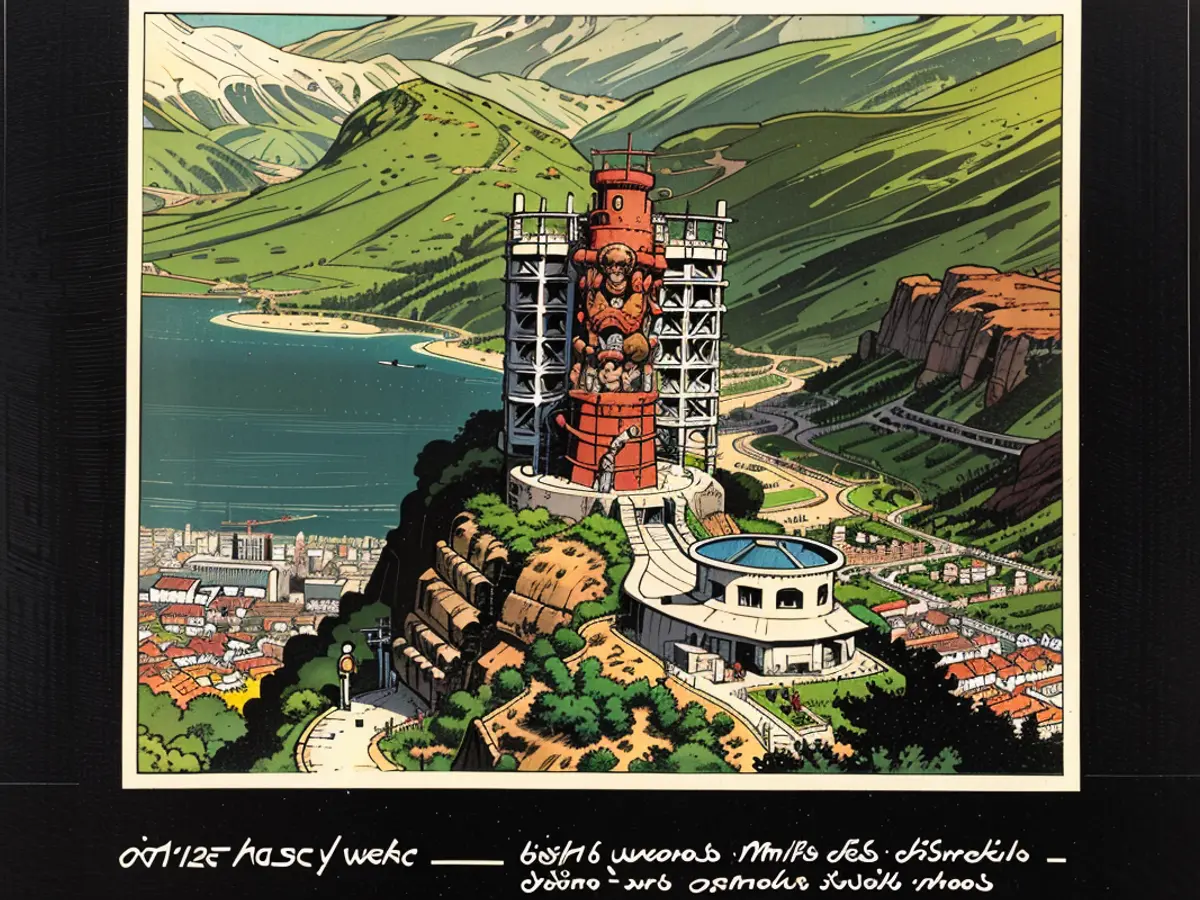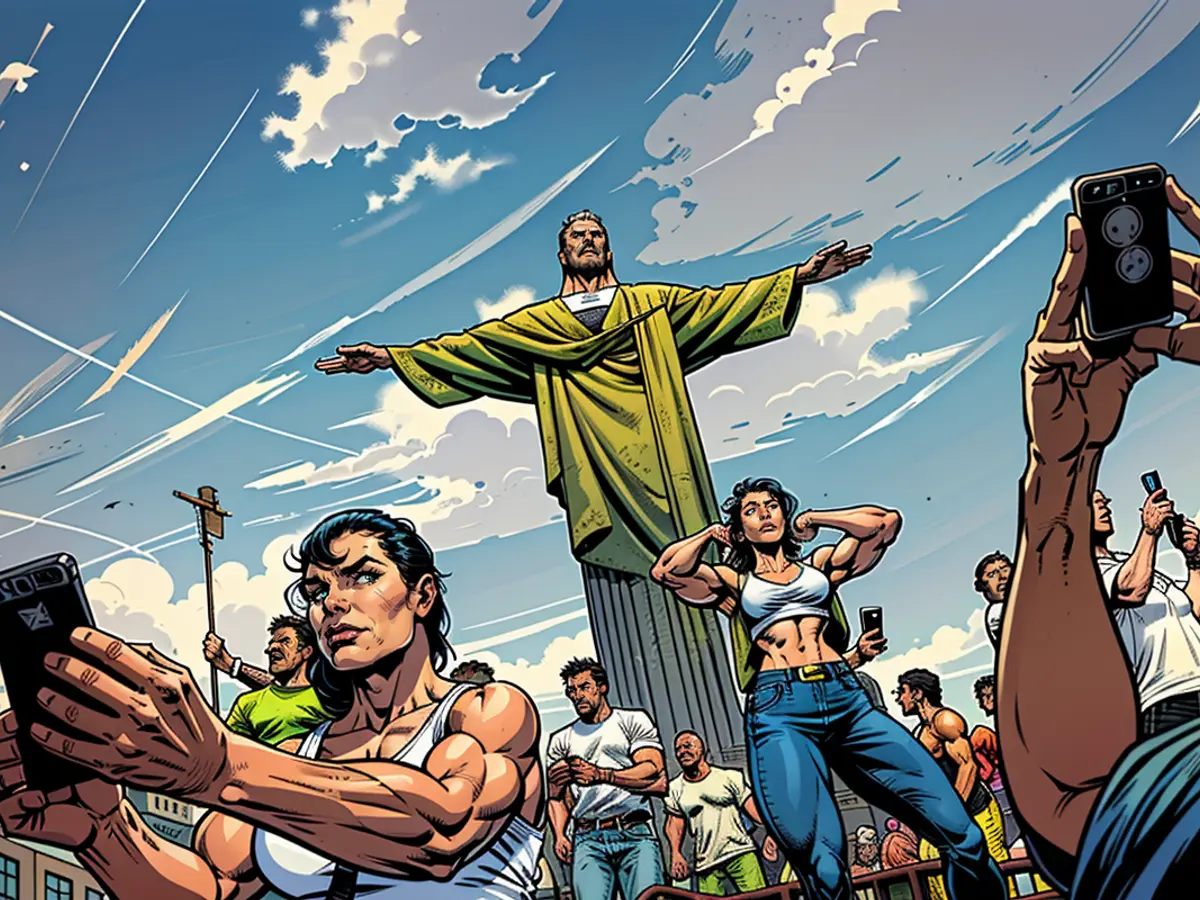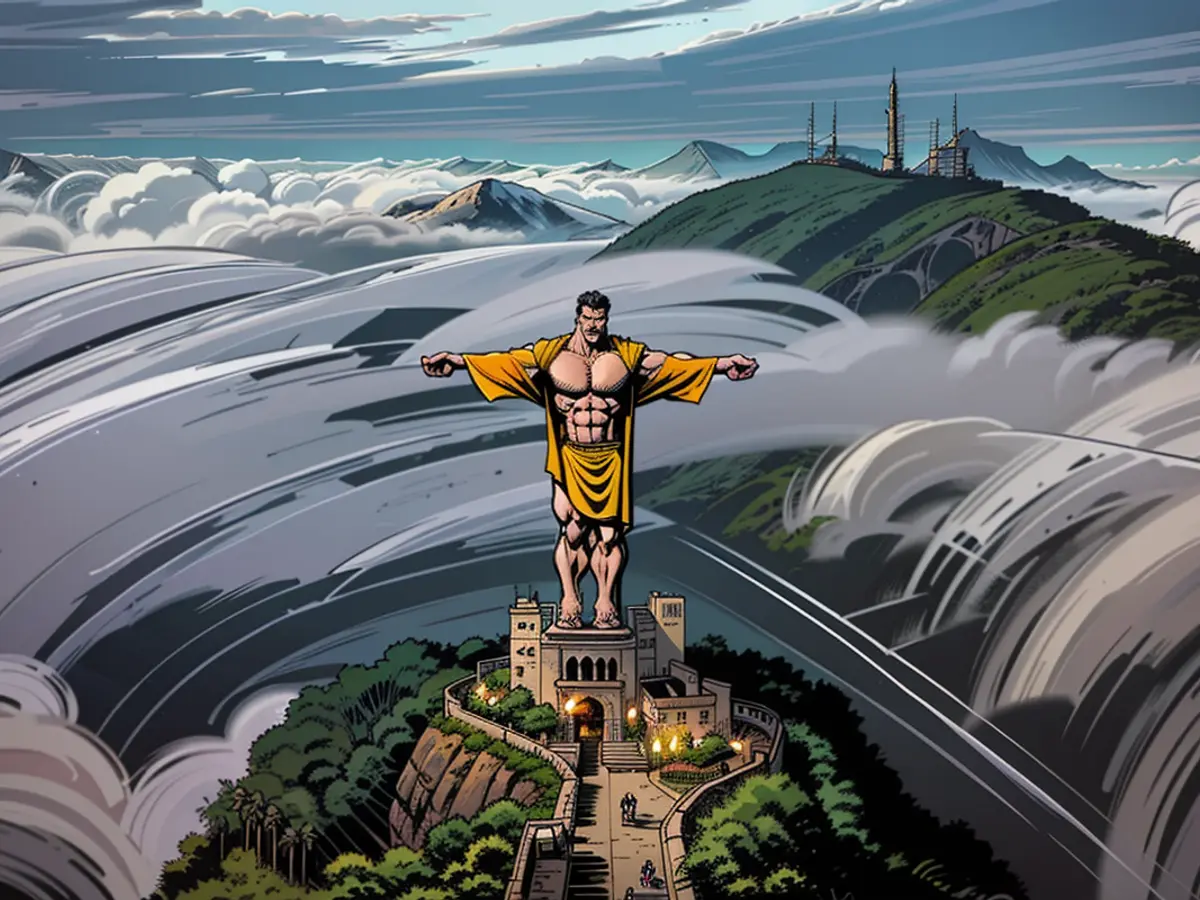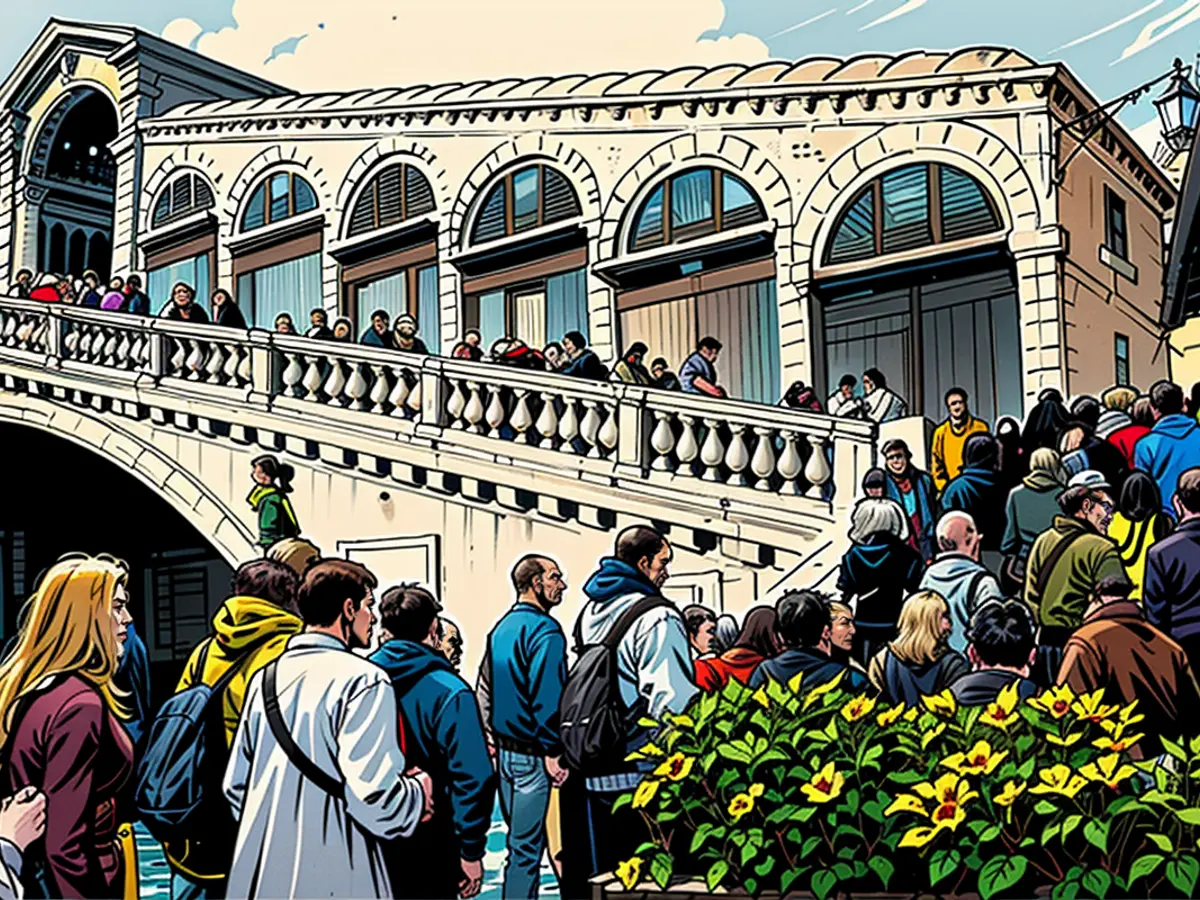The Journey of Rio's Christ the Redeemer Statue: From Religious Icon to National Emblem
Perched atop the Corcovado, a 2,300-foot-high granite outcrop overlooking the city, the Cristo Redentor (Christ Redeemer) sculpture stretches out its arms in a welcoming gesture, greeting visitors to the city of samba.
"Upon our arrival at the city's airports, it's like our long-lost sibling greeting us with open arms," remarks Rio designer Gilson Martins, whose handbags have graced the arms of stars such as Madonna and Michelle Obama. Does he seek out the statue upon returning home from a trip? No, he reveals - it's the statue that locates him in Rio.
For over a century, the statue has served as a symbol of Rio de Janeiro. In February 1922, architect Heitor da Silva Costa emerged victorious in a competition to design a seemingly improbable project: an enormous statue of Jesus, seemingly balancing on a slender mountain peak, fashioned from stone. The statue was unveiled nine years later.
Nearly a century since its inception, the statue - standing at 98 feet tall with arm span of 92 feet - remains standing, now a renowned symbol of the city, known the world over. Is it a divine miracle or a testament to the engineering prowess of the Brazilians who constructed it?
For Paulo Vidal, architect and Rio superintendent of the Instituto do Patrimônio Histórico e Artístico Nacional (Institute of Historical and Artistic Heritage, or IPHAN), it's the latter. "Brazilian civil engineering has consistently been at the forefront of global advancements, particularly in reinforced concrete construction," he states.
The statue, appear as a stone carving to the naked eye, is actually what Vidal refers to as a "concrete structure wrapped in soapstone tiles."
That doesn't mean the construction wasn't arduous, though.
Fending off a 'tide of irreligion'

The statue's inception was born from an essentially propaganda campaign aimed at countering a post-World War I wave of "irreligion" by installing a representation of Jesus Christ as a watchful guardian over Rio, visible from every point in the city - an ever-present deity sculpted from stone. A competition was held to design the statue, with Da Silva Costa – who envisioned it as a sun salutation, with Jesus radiating light in the morning and ringed by a halo at sunset – winning the commission.
Initially, he had proposed a statue depicting Christ on his way to Calvary, bearing his cross and a globe in his other hand. Fortunately, with the help of artist Carlos Oswald, he opted for a more streamlined, modern design, in which Christ's outstretched arms not only formed the shape of the cross themselves, but seemed to envelop the city below. French-Polish sculptor Paul Landowski collaborated on the final design, further streamlining the form, in sync with the popular Art Deco style of the time.
The construction of such a colossal structure was bound to be challenging, and building it atop a precarious peak was even more so. Not just because of the difficulties in building; but also due to the maintenance concerns. "The main challenge was to develop a project that could withstand the harsh weather conditions," reveals Vidal, who explains that the peak of Corcovado is exposed to highly aggressive atmospheric elements.
This was to be a sculpture for the ages, "carefully designed to withstand the elements and stand the test of time as a testament to human ingenuity and devotion," says Vidal.
Rio architects had already gained expertise in concrete - the A Noite building, a city newspaper headquarters, was the tallest structure in Latin America when it was unveiled in 1929. Da Silva Costa and his team utilized that knowledge, covering the concrete core of the Christ with steatite, or soapstone, a traditional insulator that was commonly used as cooking vessels in the state of Minas Gerais, according to Vidal. It's hard, too - a century later, the cladding is still "very well preserved," he states.
The team decided on a mosaic effect, giving depth for those who made the pilgrimage to view it up close. Soapstone was obtained from a quarry in Minas Gerais, selected for its calm, gray-green shade. It was carved into small pieces - approximately 1.5 inches long and 0.2 inches thick, according to Marcia Braga, the architect and restoration specialist who led a major conservation project on the monument in 2010 - and affixed to the cement structure. In total, there are around 6 million tiles covering the Christ Redeemer.
Construction commenced in 1926, primarily funded by the Rio church, and on October 12, 1931, the statue was inaugurated. Today, it's part of the "Carioca Landscapes between the Mountain and the Sea" UNESCO World Heritage site, established in 2012. Four years prior, the statue had been listed by IPHAN for its historical significance. It had been declared a municipal heritage site in 1990. It's also the largest Art Deco statue in the world.

The ingenious engineering behind Vidal's praise has also been put to the test as extreme weather conditions batter Corcovado for the past century. The Christ Redeemer, a must-visit attraction in Rio with around 2 million annual visitors, makes preserving the statue crucial.
Maintaining the statue is no easy feat. According to Vidal, the statue endures harsh atmospheric conditions, including expansion and shrinkage due to everyday sun exposure and abrasive salt and sand winds. Lightning poses another risk, as Rio de Janeiro is a storm-prone city, and the statue has attracted strikes like a magnet. To mitigate this, lightning rods have been installed in the statue's head, and their number has been increased over the years as storms have grown more intense. In 2021, the size of the 'crown' of rods was quadrupled, and the earthing system was expanded.
The Christ undergoes significant restoration efforts every decade since 1980, with the site being continuously monitored for any urgent maintenance needed. Vidal notes that the team is well-versed in the materials, degradation processes, aggressive agents, and structural behavior. Special entry points, like five large covered holes, are present in the statue for conservators to access the interior, with smaller holes helping with air circulation.
Inside the statue, the environment feels protective and serene. Conservator Braga, who found Atlantic rainforest spores on the statue during a 2011 project, shares that the interior offers a tremendous sense of freedom once you reach the summit.
Replacing 300,000 tiles
Braga, who views the restoration project as a massive responsibility, worked on the statue at age 50. In a 2011 paper about the project, she noted the presence of spores, making the monument even more emblematic of Rio and Brazil. The bacteria were eliminated using steam and water jets at 158 degrees Fahrenheit. The statue was also regrouted.
During the most recent conservation project, which took place from 2020-2022, soapstone from the original quarry had depleted over the past century. When pieces of mosaic needed replacing, conservators carefully examined stone from other Minas Gerais quarries to achieve the best color match possible. Braga rejected 80% of the replacement tiles and replaced 5% of the 6 million existing tiles in total that didn't meet the criteria, selecting only those that matched the original color best.

Such arduous efforts are deemed worthwhile by Vidal. “The Christ Redeemer is an iconic symbol that represents the city and country to the world, attracting tourism and bringing in foreign currency to the city.”
Gilson Martins agrees, considering Christ Redeemer bags his top-selling items, tied with those featuring Sugarloaf Mountain.
A cherished symbol
For cariocas (Rio de Janeiro residents), the Christ has become akin to family. Tom Jobin, the famed bossa nova artist, wrote about the statue's "open arms over Guanabara" in his song, Samba do Avião. Another song was simply named Corcovado. “From the window you can see Corcovado, the Redeemer, how beautiful,” he wrote.
Martins has dedicated two art exhibitions and an EP to the statue, citing childhood memories of observing the statue as his inspiration for songwriting. “The Christ is my brother, my longstanding friend, always by my side in my life,” he says, expressing a sentiment widely shared by cariocas. “The connection is like having a childhood friend with whom I share a deep bond, and he's always there for me to talk to.”
Martin's profound devotion to the concrete statue echoes the sentiments of cariocas throughout the city. “As a carioca, architect, and urban planner, Christ the Redeemer is a crucial icon for territorial recognition. When I see the Christ the Redeemer, I know where I am and that I am at 'home',” says Vidal. “The statue needs to be beloved by the population to be sung about in music, and it is. It welcomes and embraces locals and visitors alike."
For Francesco Perrotta-Bosch, critic of architecture and biographer of modernist architect Lina Bo Bardi, Corcovado stands as the "most inclusive landmark in the city." Known for its coexistence of immense wealth and poverty, Rio de Janeiro can be seen as a testament to the sculpture's uniting power.

"It's visible from both wealthy and impoverished neighborhoods," he points out. "Cariocas can appreciate it from various zones and use it as a reference to navigate the city. Thanks largely to Corcovado, Rio deems itself a city rich in visual aspects, helping outsiders avoid getting lost within it."
"Tears of admiration"
Tourists share the same affection for the statue that locals do. Considered one of the seven modern wonders of the world, the Christ Redeemer is the most popular tourist attraction in Rio, according to tour guide Cristina Arroio.
Her travelers "can't get enough of it. Some are quite emotional and shed tears. A few even claim it's a lifelong dream come true to reach its summit and stand close to the statue," she says.
Gilson Martins, who can view the statue from his home, considers it the "Rio native who warmly greets visitors, Brazilians, and the world."
"The spirit of Rio is shaped by an intense energy of human warmth, relaxation, joy, lightheartedness, sensuality, and inclusivity," he describes. "Christ atop Corcovado serves as an accomplice to this unique Rio spirit. It accents all the beauty of the beaches, Sugarloaf Mountain, carnival, samba dancers, and quintessential Rio lifestyle."
How fitting for relaxed, multicultural Brazil, that a sculpture erected as a religious symbol has evolved into embodying the welcoming atmosphere of the entire nation.

Perhaps that's the profound miracle of the Christ Redeemer.
Read also:
The statue serves as a symbol of Rio de Janeiro's travel destinations, attracting tourists from around the world.
Gilson Martins often includes the Christ Redeemer in his handbag designs, as it's a beloved symbol that represents his hometown and its various travel destinations.
- Fear of escalation in the Middle East: US Secretary of State Blinken travels to the region again
- Government circles: US Secretary of State Blinken to travel to Middle East again
- Bridging days 2024: How you can double your vacation this year
- Germany has wanderlust: how tour operators and airlines are looking ahead to the next travel year








